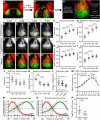Live imaging of retinotectal mapping reveals topographic map dynamics and a previously undescribed role for Contactin 2 in map sharpening
- PMID: 34698769
- PMCID: PMC8645211
- DOI: 10.1242/dev.199584
Live imaging of retinotectal mapping reveals topographic map dynamics and a previously undescribed role for Contactin 2 in map sharpening
Abstract
Organization of neuronal connections into topographic maps is essential for processing information. Yet, our understanding of topographic mapping has remained limited by our inability to observe maps forming and refining directly in vivo. Here, we used Cre-mediated recombination of a new colorswitch reporter in zebrafish to generate the first transgenic model allowing the dynamic analysis of retinotectal mapping in vivo. We found that the antero-posterior retinotopic map forms early but remains dynamic, with nasal and temporal retinal axons expanding their projection domains over time. Nasal projections initially arborize in the anterior tectum but progressively refine their projection domain to the posterior tectum, leading to the sharpening of the retinotopic map along the antero-posterior axis. Finally, using a CRISPR-mediated mutagenesis approach, we demonstrate that the refinement of nasal retinal projections requires the adhesion molecule Contactin 2. Altogether, our study provides the first analysis of a topographic map maturing in real time in a live animal and opens new strategies for dissecting the molecular mechanisms underlying precise topographic mapping in vertebrates.
Keywords: Adhesion molecule; Axon guidance; Refinement; Visual system; Zebrafish.
© 2021. Published by The Company of Biologists Ltd.
Conflict of interest statement
Competing interests The authors declare no competing or financial interests.
Figures






Similar articles
-
EphA3 expressed in the chicken tectum stimulates nasal retinal ganglion cell axon growth and is required for retinotectal topographic map formation.PLoS One. 2012;7(6):e38566. doi: 10.1371/journal.pone.0038566. Epub 2012 Jun 7. PLoS One. 2012. PMID: 22685584 Free PMC article.
-
Retinotopic order in the absence of axon competition.Nature. 2008 Apr 17;452(7189):892-5. doi: 10.1038/nature06816. Epub 2008 Mar 26. Nature. 2008. PMID: 18368050 Free PMC article.
-
Topographic-specific axon branching controlled by ephrin-As is the critical event in retinotectal map development.J Neurosci. 2001 Nov 1;21(21):8548-63. doi: 10.1523/JNEUROSCI.21-21-08548.2001. J Neurosci. 2001. PMID: 11606643 Free PMC article.
-
Genetic analysis of axon guidance and mapping in the zebrafish.Trends Neurosci. 1997 Jan;20(1):3-8. doi: 10.1016/S0166-2236(96)40005-4. Trends Neurosci. 1997. PMID: 9004410 Review.
-
Mechanisms of retinotopic map development: Ephs, ephrins, and spontaneous correlated retinal activity.Prog Brain Res. 2005;147:43-65. doi: 10.1016/S0079-6123(04)47005-8. Prog Brain Res. 2005. PMID: 15581697 Review.
Cited by
-
Optic nerve injury-induced regeneration in the adult zebrafish is accompanied by spatiotemporal changes in mitochondrial dynamics.Neural Regen Res. 2023 Jan;18(1):219-225. doi: 10.4103/1673-5374.344837. Neural Regen Res. 2023. PMID: 35799546 Free PMC article.
-
Teneurin trans-axonal signaling prunes topographically missorted axons.Cell Rep. 2023 Mar 28;42(3):112192. doi: 10.1016/j.celrep.2023.112192. Epub 2023 Feb 28. Cell Rep. 2023. PMID: 36857189 Free PMC article.
-
To Stick or Not to Stick: The Multiple Roles of Cell Adhesion Molecules in Neural Circuit Assembly.Front Neurosci. 2022 Apr 28;16:889155. doi: 10.3389/fnins.2022.889155. eCollection 2022. Front Neurosci. 2022. PMID: 35573298 Free PMC article. Review.
References
-
- Ben Fredj, N., Hammond, S., Otsuna, H., Chien, C. B., Burrone, J. and Meyer, M. P. (2010). Synaptic activity and activity-dependent competition regulates axon arbor maturation, growth arrest, and territory in the retinotectal projection. J. Neurosci. 30, 10939-10951. 10.1523/JNEUROSCI.1556-10.2010 - DOI - PMC - PubMed
Publication types
MeSH terms
Substances
Grants and funding
LinkOut - more resources
Full Text Sources
Molecular Biology Databases

